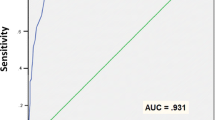Abstract
This study examines the psychometric properties of two versions of the PTSD Sympton Scale (PSS). The scale contains 17 items that diagnose PTSD according to DSM-III-R criteria and assess the severity of PTSD symptoms. An interview and self-report version of the PSS were administered to a sample of 118 recent rape and non-sexual assault victims. The results indicate that both versions of the PSS have satisfactory internal consistency, high test-retest reliability, and good concurrent validity. The interview version yielded high interrater agreement when administred separately by two interviewers and excellent convergent validity with the SCID. When used to diagnose PTSD, the self-report version of the PSS was somewhat more conservative than the interview version.
Similar content being viewed by others
References
American Psychiatric Association (1980).Diagnosis and statistical manual of mental disorders (3rd Edition). Washington, D.C.: Author.
American Psychiatric Association (1987).Diagnosis and statistical manual of mental disorders (3rd Edition, rev.). Washington, D.C.: Author.
Atkeson, B., Calhoun, K., Resick, P., and Ellis, E. (1982). Victims of rape: Repeated assessment of depressive symptoms.J. Consult. Clin. Psychol. 50: 96–102.
Beck, A. T., Ward, C. H., Mendelsohn, M., Mock, J., and Erbaugh, J. (1961). An inventory for measuring depression.Arch. Gen. Psychiatry 4: 561–571.
Davidson, J., Smith, R., and Kudler, H. (1989). Validity and reliability of the DSM-III criteria for posttraumatic stress disorder: Experience with a structured interview.J. Nerv. Ment. Dis. 177: 336–341.
Horowitz, M. J., Wilner, N., and Alvarez, W. (1979). Impact of event scale: A measure of subjective distress.Psychosom. Med. 41: 207–218.
Keane, T. M., Caddell, J. M., and Taylor, K. T. (1988). Mississippi scale for combat-related posttraumatic stress disorder: Three studies in reliability and validity.J. Consult. Clin. Psychol. 56: 85–90.
Kilpatrick, D. G. (1988). Rape aftermath symptom test. In Hersen, M., and Bellack, A. S. (eds.),Dictionary of Behavioral Assessment Techniques Pergamon Press, Oxford.
Kilpatrick, D. G., Amick, A., and Resnick, H. S. (1988, September).Preliminary research data on post-traumatic stress disorder following murders and drunk driving crashes, Paper presented at the National Organization for Victim Assistance's 14th Annual Meeting, Tucson, Arizona.
Kilpatrick, D. G., Saunders, B. E., Veronen, L. J., Best, C. L., and Von, J. M. (1987). Criminal victimization: Lifetime prevalence, reporting to police, and psychological impact.Crime Delin. 33: 479–489.
Putnam, J. J. (1881). Recent investigations into patients of so-called concussion of the spine.Boston Med. Surg. J. 109: 217.
Rado, S. (1942). Pathodynamics and treatment of traumatic war neurosis (traumatophobia).Psychosom. Med. 42: 363–368.
Rigler, R. (1879). Bever die Folgen der Verletzungen auf Eisenbahnen, insbesondere der Verletzungen des Ruckenmarks.Mit Hinblick auf das Haftpflichfgesetz dargestellf VIII, 124: 80, Berlin, Germany.
Robins, L. N., Helzer, J. D., Croughan, J., and Ratcliff, K. S. (1981). The NIMH diagnostic interview schedule: Its history characteristics and validity.Arch. Gen. Psychiatr 38: 381–389.
Rothbaum, B. O., Foa, E. B., Riggs, D. S., Murdock, T., and Walsh, W. (1991).Post-traumatic stress disorder following rape. (Unpublished manuscript).
Spielberger, C. D., Gorsuch, R. L., and Lushene, R. E. (1970).Manual for the State-Trait Anxiety Inventory (self-evaluation questionnaire) Consulting Psychologists Press, Palo Alto, CA.
Spitzer, R. L., Williams, J. B. W., and Gibbon, M. (1987).Structured Clinical Interview for DSM-III-R (SCID) Biometrics Research Department, New York State Psychiatric Institute, New York.
Weisenberg, M., Solomon, Z., Schwarzwald, J., and Mikulincer, M. (1987). Assessing the severity of posttraumatic stress disorder: Relation between dichotomous and continuous measures.J. Consult. Clin. Psychol. 55: 432–434.
Author information
Authors and Affiliations
About this article
Cite this article
Foa, E.B., Riggs, D.S., Dancu, C.V. et al. Reliability and validity of a brief instrument for assessing post-traumatic stress disorder. J Trauma Stress 6, 459–473 (1993). https://doi.org/10.1007/BF00974317
Issue Date:
DOI: https://doi.org/10.1007/BF00974317




